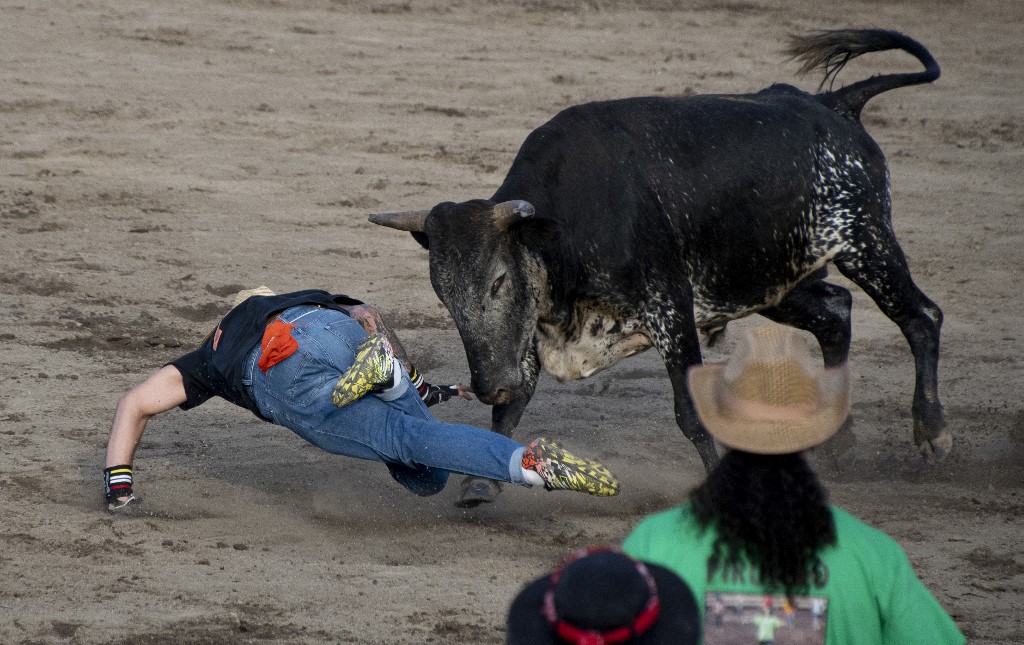A bull comes out of the pens, charges and throws improvised bullfighters through the air to win the public’s ovation. A twist that in Costa Rica turns bullfighting upside down. No matadors, no picadors, no banderilleros. In these New Year’s Eve bullfighting festivities, the animal is not touched and is applauded for catching the adventurous who hope to cut it down in the arena of the “redondel” (bullring) of Zapote, a neighborhood in the east of San José, with a capacity for 3,000 spectators.
“Unlike bullfighting, in which the animal is harmed, here the animal is not harmed. It’s a bit more like the Roman circus,” says Alvaro Lopez, 42, the event’s producer. People enjoy, comment and laugh while a Zaino Miura bull (noted for its bravery) weighing some 450 kilos kicks an improvised bullfighter on the ground after he slipped while performing a “remove”.
“It’s a bull, which is an animal that you can’t control, that can gore you, that can hit you, but still people like that, that’s what they like, what pleases them. In this show here in Costa Rica they say ‘if no one was rolled by the bull, the show was bad’,” says Lopez.
It is forbidden to kill the bull
This festejo celebrates the opposite of traditional Spanish bullfighting, where a bullfighter is acclaimed for fighting a bull. In Costa Rica, people are unfamiliar with the improvised bullfighters but know the names and exploits of the animals in previous festejos, as the bull is not killed and can participate again 30 days later in other bullrings, according to the law.
The regulation prohibits “killing the bull” and the animals are inspected before, during and after the bullfights by members of the veterinary service of the Ministry of Agriculture and Livestock. “These bulls that come here are like athletes,” says López.
Cattle rancher Luis Collado says that his bulls “play” in the bullrings once a month because “the animal is cared for and protected”. But for Juan Carlos Peralta, president of the Asociación para el Bienestar y Amparo Animal, the festejo also generates “suffering” in the bulls.
“There is no longer any excuse to say that it is tradition. They are simply profiteers who, in order to profit from animal suffering, continue with this type of activity,” says Peralta.
Improvised bullfighters
In front of the animal’s horns, several dozens of improvised bullfighters provoke the onslaught with shouts and fuss. They do not wear a bullfighter’s costume, they barely have a cape and their objective is clear: to run so as not to be gored. It is essential to wear “comfortable shoes like tennis shoes or soccer cleats,” says Maynor Jiménez, a 37-year-old construction worker who becomes a bullfighter when he puts on his Mexican wrestler’s mask.
Nine years ago he had a “lenvantín” and a bull gored him so many times that he had to spend nine days in the hospital. “A ‘levantín’ is when the bull goes after a person and picks him up and pulls him up, falls and picks him up again and rolls him around in the arena,” Jiménez explains in the alley waiting for the fourth of the afternoon.
Next to him William Portugués, a 54-year-old security systems installer, prepares himself along with the rest of the improvised bullfighters. “It’s very dangerous, at any moment a bull can gore you, it can kill you,” he warns before the animal’s imminent entry into the ring.
“The worst thing is to have lost many companions who have died here or in the hospital through a nasty goring,” recalls Portugués after listing broken bones in various parts of his body after encounters with the bulls.
Colonial tradition
Every day from December 25 until January 8 there are two bullfights per day and 20 to 30 improvised bullfighters enter the ring with the intention of trimming the 10 to 12 bulls in each festejo. Admission costs about 25 dollars.
The tradition dates back to colonial times and in 2022 it returns after three years suspended due to the coronavirus pandemic.
The return of the “Toros a la tica” marks the arrival of Christmas and New Year and according to a 2015 University of Costa Rica survey 62.7% acknowledge that they “like” these festivities.
50.2% say they have ever been to the bullring and 94.5% have seen it on television. The bullfights are broadcast live simultaneously on several channels as if they were soccer matches.







